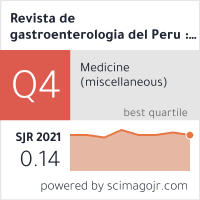Local staging of rectal carcinoma: endorectal ultrasound versus magnetic resonance imaging. Systematic review of literature and meta-analysis
DOI:
https://doi.org/10.47892/rgp.2016.361.22Keywords:
Rectal cancer, Magnetic resonance imaging, UltrasonographyAbstract
New surgical techniques in the treatment of rectal cancer have improved survival mainly by reducing local recurrences. A preoperative staging method is required to accurately identify tumor stage and planning the appropriate treatment. MRI and ERUS are currently being used for the local staging (T stage). In this review, the accuracy of MRI and ERUS with rigid probe was compared against the gold standard of the pathological findings in the resection specimens. Five studies met the inclusion criteria and were included in this meta-analysis. The accuracy was 91.0% to ERUS and 86.8% to MRI (p=0.27). The result has no statistical significance but with pronounced heterogeneity between the included trials as well as other published reviews. We can conclude that there is a clear need for good quality, larger scale and prospective studies.Downloads
Download data is not yet available.
Metrics
Metrics Loading ...
Downloads
Published
07/17/2016
How to Cite
1.
Guenaga KF, Otoch JP, Artifon ELA. Local staging of rectal carcinoma: endorectal ultrasound versus magnetic resonance imaging. Systematic review of literature and meta-analysis. Rev Gastroenterol Peru [nternet]. 2016 Jul. 17 [cited 2025 Dec. 17];36(1):43-8. vailable from: https://revistagastroperu.com/index.php/rgp/article/view/22
Issue
Section
ARTÍCULOS ORIGINALES
License
Revista de Gastroenterología del Perú by Sociedad Peruana de Gastroenterología del Perú is licensed under a Licencia Creative Commons Atribución 4.0 Internacional..
Aquellos autores/as que tengan publicaciones con esta revista, aceptan los términos siguientes:
- Los autores/as conservarán sus derechos de autor y garantizarán a la revista el derecho de primera publicación de su obra, el cuál estará simultáneamente sujeto a la Licencia de reconocimiento de Creative Commons que permite a terceros compartir la obra siempre que se indique su autor y su primera publicación esta revista.
- Los autores/as podrán adoptar otros acuerdos de licencia no exclusiva de distribución de la versión de la obra publicada (p. ej.: depositarla en un archivo telemático institucional o publicarla en un volumen monográfico) siempre que se indique la publicación inicial en esta revista.
- Se permite y recomienda a los autores/as difundir su obra a través de Internet (p. ej.: en archivos telemáticos institucionales o en su página web) antes y durante el proceso de envío, lo cual puede producir intercambios interesantes y aumentar las citas de la obra publicada. (Véase El efecto del acceso abierto).
















 2022
2022 